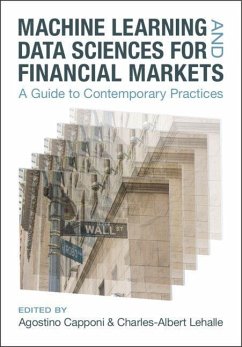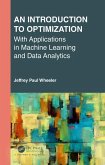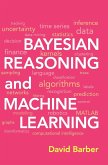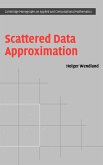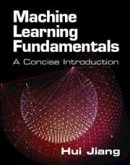Machine Learning and Data Sciences for Financial Markets
A Guide to Contemporary Practices
Herausgeber: Capponi, Agostino; Lehalle, Charles-Albert
Machine Learning and Data Sciences for Financial Markets
A Guide to Contemporary Practices
Herausgeber: Capponi, Agostino; Lehalle, Charles-Albert
- Gebundenes Buch
- Merkliste
- Auf die Merkliste
- Bewerten Bewerten
- Teilen
- Produkt teilen
- Produkterinnerung
- Produkterinnerung
Written by more than sixty experts in the area, this book reviews cutting-edge practices in machine learning for financial markets, and explores connections with data science and more traditional approaches. This is an invaluable resource for researchers and graduate students in financial engineering, as well as practitioners in the sector.
Andere Kunden interessierten sich auch für
![The Statistical Physics of Data Assimilation and Machine Learning The Statistical Physics of Data Assimilation and Machine Learning]() Henry D. I. Abarbanel (San Diego University of California)The Statistical Physics of Data Assimilation and Machine Learning78,99 €
Henry D. I. Abarbanel (San Diego University of California)The Statistical Physics of Data Assimilation and Machine Learning78,99 €![An Introduction to Optimization with Applications in Machine Learning and Data Analytics An Introduction to Optimization with Applications in Machine Learning and Data Analytics]() Jeffrey Paul WheelerAn Introduction to Optimization with Applications in Machine Learning and Data Analytics77,99 €
Jeffrey Paul WheelerAn Introduction to Optimization with Applications in Machine Learning and Data Analytics77,99 €![Experimental Design and Data Analysis for Biologists Experimental Design and Data Analysis for Biologists]() Gerry P. Quinn (Victoria Monash University)Experimental Design and Data Analysis for Biologists73,99 €
Gerry P. Quinn (Victoria Monash University)Experimental Design and Data Analysis for Biologists73,99 €![Bayesian Reasoning and Machine Learning Bayesian Reasoning and Machine Learning]() David Barber (University College London)Bayesian Reasoning and Machine Learning139,99 €
David Barber (University College London)Bayesian Reasoning and Machine Learning139,99 €![Scattered Data Approximation Scattered Data Approximation]() Holger Wendland (Georg-August-Universitat, Gottingen, Germany)Scattered Data Approximation160,99 €
Holger Wendland (Georg-August-Universitat, Gottingen, Germany)Scattered Data Approximation160,99 €![Machine Learning Fundamentals Machine Learning Fundamentals]() Hui Jiang (Toronto York University)Machine Learning Fundamentals60,99 €
Hui Jiang (Toronto York University)Machine Learning Fundamentals60,99 €![Introduction to Intelligent Systems, Control, and Machine Learning Using MATLAB Introduction to Intelligent Systems, Control, and Machine Learning Using MATLAB]() Marco P. Schoen (Idaho State University)Introduction to Intelligent Systems, Control, and Machine Learning Using MATLAB108,99 €
Marco P. Schoen (Idaho State University)Introduction to Intelligent Systems, Control, and Machine Learning Using MATLAB108,99 €-
-
-
Written by more than sixty experts in the area, this book reviews cutting-edge practices in machine learning for financial markets, and explores connections with data science and more traditional approaches. This is an invaluable resource for researchers and graduate students in financial engineering, as well as practitioners in the sector.
Hinweis: Dieser Artikel kann nur an eine deutsche Lieferadresse ausgeliefert werden.
Hinweis: Dieser Artikel kann nur an eine deutsche Lieferadresse ausgeliefert werden.
Produktdetails
- Produktdetails
- Verlag: Cambridge University Press
- Seitenzahl: 741
- Erscheinungstermin: 1. Juni 2023
- Englisch
- Abmessung: 257mm x 182mm x 38mm
- Gewicht: 1666g
- ISBN-13: 9781316516195
- ISBN-10: 1316516199
- Artikelnr.: 67177357
- Herstellerkennzeichnung
- Libri GmbH
- Europaallee 1
- 36244 Bad Hersfeld
- gpsr@libri.de
- Verlag: Cambridge University Press
- Seitenzahl: 741
- Erscheinungstermin: 1. Juni 2023
- Englisch
- Abmessung: 257mm x 182mm x 38mm
- Gewicht: 1666g
- ISBN-13: 9781316516195
- ISBN-10: 1316516199
- Artikelnr.: 67177357
- Herstellerkennzeichnung
- Libri GmbH
- Europaallee 1
- 36244 Bad Hersfeld
- gpsr@libri.de
Interacting with Investors and Asset Owners: Part I. Robo-advisors and
Automated Recommendation: 1. Introduction to Part I. Robo-advising as a
technological platform for optimization and recommendations; 2. New
frontiers of robo-advising: consumption, saving, debt management, and
taxes; 3. Robo-advising: less AI and more XAI? Augmenting algorithms with
humans-in-the-loop; 4. Robo-advisory: from investing principles and
algorithms to future developments; 5. Recommender systems for corporate
bond trading; Part II. How Learned Flows Form Prices: 6. Introduction to
Part II. Price impact: information revelation or self-fulfilling
prophecies?; 7. Order flow and price formation; 8. Price formation and
learning in equilibrium under asymmetric information; 9. Deciphering how
investors' daily flows are forming prices; Towards Better Risk
Intermediation: Part III. High Frequency Finance: 10. Introduction to Part
III; 11. Reinforcement learning methods in algorithmic trading; 12.
Stochastic approximation applied to optimal execution: learning by trading;
13. Reinforcement learning for algorithmic trading; Part IV. Advanced
Optimization Techniques: 14. Introduction to Part IV. Advanced optimization
techniques for banks and asset managers; 15. Harnessing quantitative
finance by data-centric methods; 16. Asset pricing and investment with big
data; 17. Portfolio construction using stratified models; Part V. New
Frontiers for Stochastic Control in Finance: 18. Introduction to Part V.
Machine learning and applied mathematics: a game of hide-and-seek?; 19. The
curse of optimality, and how to break it?; 20. Deep learning for mean field
games and mean field control with applications to finance; 21.
Reinforcement learning for mean field games, with applications to
economics; 22. Neural networks-based algorithms for stochastic control and
PDEs in finance; 23. Generative adversarial networks: some analytical
perspectives; Connections with the Real Economy: Part VI. Nowcasting with
Alternative Data: 24. Introduction to Part VI. Nowcasting is coming; 25.
Data preselection in machine learning methods: an application to
macroeconomic nowcasting with Google search data; 26. Alternative data and
ML for macro nowcasting; 27. Nowcasting corporate financials and consumer
baskets with alternative data; 28. NLP in finance; 29. The exploitation of
recurrent satellite imaging for the fine-scale observation of human
activity; Part VII. Biases and Model Risks of Data-Driven Learning: 30.
Introduction to Part VII. Towards the ideal mix between data and models;
31. Generative Pricing model complexity: the case for volatility-managed
portfolios; 32. Bayesian deep fundamental factor models; 33. Black-box
model risk in finance; Index.
Automated Recommendation: 1. Introduction to Part I. Robo-advising as a
technological platform for optimization and recommendations; 2. New
frontiers of robo-advising: consumption, saving, debt management, and
taxes; 3. Robo-advising: less AI and more XAI? Augmenting algorithms with
humans-in-the-loop; 4. Robo-advisory: from investing principles and
algorithms to future developments; 5. Recommender systems for corporate
bond trading; Part II. How Learned Flows Form Prices: 6. Introduction to
Part II. Price impact: information revelation or self-fulfilling
prophecies?; 7. Order flow and price formation; 8. Price formation and
learning in equilibrium under asymmetric information; 9. Deciphering how
investors' daily flows are forming prices; Towards Better Risk
Intermediation: Part III. High Frequency Finance: 10. Introduction to Part
III; 11. Reinforcement learning methods in algorithmic trading; 12.
Stochastic approximation applied to optimal execution: learning by trading;
13. Reinforcement learning for algorithmic trading; Part IV. Advanced
Optimization Techniques: 14. Introduction to Part IV. Advanced optimization
techniques for banks and asset managers; 15. Harnessing quantitative
finance by data-centric methods; 16. Asset pricing and investment with big
data; 17. Portfolio construction using stratified models; Part V. New
Frontiers for Stochastic Control in Finance: 18. Introduction to Part V.
Machine learning and applied mathematics: a game of hide-and-seek?; 19. The
curse of optimality, and how to break it?; 20. Deep learning for mean field
games and mean field control with applications to finance; 21.
Reinforcement learning for mean field games, with applications to
economics; 22. Neural networks-based algorithms for stochastic control and
PDEs in finance; 23. Generative adversarial networks: some analytical
perspectives; Connections with the Real Economy: Part VI. Nowcasting with
Alternative Data: 24. Introduction to Part VI. Nowcasting is coming; 25.
Data preselection in machine learning methods: an application to
macroeconomic nowcasting with Google search data; 26. Alternative data and
ML for macro nowcasting; 27. Nowcasting corporate financials and consumer
baskets with alternative data; 28. NLP in finance; 29. The exploitation of
recurrent satellite imaging for the fine-scale observation of human
activity; Part VII. Biases and Model Risks of Data-Driven Learning: 30.
Introduction to Part VII. Towards the ideal mix between data and models;
31. Generative Pricing model complexity: the case for volatility-managed
portfolios; 32. Bayesian deep fundamental factor models; 33. Black-box
model risk in finance; Index.
Interacting with Investors and Asset Owners: Part I. Robo-advisors and
Automated Recommendation: 1. Introduction to Part I. Robo-advising as a
technological platform for optimization and recommendations; 2. New
frontiers of robo-advising: consumption, saving, debt management, and
taxes; 3. Robo-advising: less AI and more XAI? Augmenting algorithms with
humans-in-the-loop; 4. Robo-advisory: from investing principles and
algorithms to future developments; 5. Recommender systems for corporate
bond trading; Part II. How Learned Flows Form Prices: 6. Introduction to
Part II. Price impact: information revelation or self-fulfilling
prophecies?; 7. Order flow and price formation; 8. Price formation and
learning in equilibrium under asymmetric information; 9. Deciphering how
investors' daily flows are forming prices; Towards Better Risk
Intermediation: Part III. High Frequency Finance: 10. Introduction to Part
III; 11. Reinforcement learning methods in algorithmic trading; 12.
Stochastic approximation applied to optimal execution: learning by trading;
13. Reinforcement learning for algorithmic trading; Part IV. Advanced
Optimization Techniques: 14. Introduction to Part IV. Advanced optimization
techniques for banks and asset managers; 15. Harnessing quantitative
finance by data-centric methods; 16. Asset pricing and investment with big
data; 17. Portfolio construction using stratified models; Part V. New
Frontiers for Stochastic Control in Finance: 18. Introduction to Part V.
Machine learning and applied mathematics: a game of hide-and-seek?; 19. The
curse of optimality, and how to break it?; 20. Deep learning for mean field
games and mean field control with applications to finance; 21.
Reinforcement learning for mean field games, with applications to
economics; 22. Neural networks-based algorithms for stochastic control and
PDEs in finance; 23. Generative adversarial networks: some analytical
perspectives; Connections with the Real Economy: Part VI. Nowcasting with
Alternative Data: 24. Introduction to Part VI. Nowcasting is coming; 25.
Data preselection in machine learning methods: an application to
macroeconomic nowcasting with Google search data; 26. Alternative data and
ML for macro nowcasting; 27. Nowcasting corporate financials and consumer
baskets with alternative data; 28. NLP in finance; 29. The exploitation of
recurrent satellite imaging for the fine-scale observation of human
activity; Part VII. Biases and Model Risks of Data-Driven Learning: 30.
Introduction to Part VII. Towards the ideal mix between data and models;
31. Generative Pricing model complexity: the case for volatility-managed
portfolios; 32. Bayesian deep fundamental factor models; 33. Black-box
model risk in finance; Index.
Automated Recommendation: 1. Introduction to Part I. Robo-advising as a
technological platform for optimization and recommendations; 2. New
frontiers of robo-advising: consumption, saving, debt management, and
taxes; 3. Robo-advising: less AI and more XAI? Augmenting algorithms with
humans-in-the-loop; 4. Robo-advisory: from investing principles and
algorithms to future developments; 5. Recommender systems for corporate
bond trading; Part II. How Learned Flows Form Prices: 6. Introduction to
Part II. Price impact: information revelation or self-fulfilling
prophecies?; 7. Order flow and price formation; 8. Price formation and
learning in equilibrium under asymmetric information; 9. Deciphering how
investors' daily flows are forming prices; Towards Better Risk
Intermediation: Part III. High Frequency Finance: 10. Introduction to Part
III; 11. Reinforcement learning methods in algorithmic trading; 12.
Stochastic approximation applied to optimal execution: learning by trading;
13. Reinforcement learning for algorithmic trading; Part IV. Advanced
Optimization Techniques: 14. Introduction to Part IV. Advanced optimization
techniques for banks and asset managers; 15. Harnessing quantitative
finance by data-centric methods; 16. Asset pricing and investment with big
data; 17. Portfolio construction using stratified models; Part V. New
Frontiers for Stochastic Control in Finance: 18. Introduction to Part V.
Machine learning and applied mathematics: a game of hide-and-seek?; 19. The
curse of optimality, and how to break it?; 20. Deep learning for mean field
games and mean field control with applications to finance; 21.
Reinforcement learning for mean field games, with applications to
economics; 22. Neural networks-based algorithms for stochastic control and
PDEs in finance; 23. Generative adversarial networks: some analytical
perspectives; Connections with the Real Economy: Part VI. Nowcasting with
Alternative Data: 24. Introduction to Part VI. Nowcasting is coming; 25.
Data preselection in machine learning methods: an application to
macroeconomic nowcasting with Google search data; 26. Alternative data and
ML for macro nowcasting; 27. Nowcasting corporate financials and consumer
baskets with alternative data; 28. NLP in finance; 29. The exploitation of
recurrent satellite imaging for the fine-scale observation of human
activity; Part VII. Biases and Model Risks of Data-Driven Learning: 30.
Introduction to Part VII. Towards the ideal mix between data and models;
31. Generative Pricing model complexity: the case for volatility-managed
portfolios; 32. Bayesian deep fundamental factor models; 33. Black-box
model risk in finance; Index.

